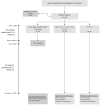A Randomized Double-Blinded Placebo Controlled Trial of Clazakizumab for the Treatment of COVID-19 Pneumonia With Hyperinflammation
- PMID: 35583232
- PMCID: PMC9380150
- DOI: 10.1097/CCM.0000000000005591
A Randomized Double-Blinded Placebo Controlled Trial of Clazakizumab for the Treatment of COVID-19 Pneumonia With Hyperinflammation
Abstract
Objectives: We designed this study to test whether clazakizumab, a direct interleukin-6 inhibitor, benefits patients hospitalized with severe or critical COVID-19 disease accompanied by hyperinflammation.
Design: Multicenter, randomized, double-blinded, placebo-controlled, seamless phase II/III trial.
Setting: Five U.S. medical centers.
Patients: Adults inpatients with severe COVID-19 disease and hyperinflammation.
Interventions: Eighty-one patients enrolled in phase II, randomized 1:1:1 to low-dose (12.5 mg) or high-dose (25 mg) clazakizumab or placebo. Ninety-seven patients enrolled in phase III, randomized 1:1 to high-dose clazakizumab or placebo.
Measurements and main results: The primary outcome was 28-day ventilator-free survival. Secondary outcomes included overall survival, frequency and duration of intubation, and frequency and duration of ICU admission. Per Data Safety and Monitoring Board recommendations, additional secondary outcomes describing clinical status and status changes, as measured by an ordinal scale, were added. Bayesian cumulative proportional odds, logistic, and Poisson regression models were used. The low-dose arm was dropped when the phase II study suggested superiority of the high-dose arm. We report on 152 patients, 74 randomized to placebo and 78 to high-dose clazakizumab. Patients receiving clazakizumab had greater odds of 28-day ventilator-free survival (odds ratio [OR] = 3.84; p [OR > 1] 99.9%), as well as overall survival at 28 and 60 days (OR = 1.75; p [OR > 1] 86.5% and OR = 2.53; p [OR > 1] 97.7%). Clazakizumab was associated with lower odds of intubation (OR = 0.2; p [OR] < 1; 99.9%) and ICU admission (OR = 0.26; p [OR < 1] 99.6%); shorter durations of ventilation and ICU stay (risk ratio [RR] < 0.75; p [RR < 1] > 99% for both); and greater odds of improved clinical status at 14, 28, and 60 days (OR = 2.32, p [OR > 1] 98.1%; OR = 3.36, p [OR > 1] 99.6%; and OR = 3.52, p [OR > 1] 99.8%, respectively).
Conclusions: Clazakizumab significantly improved 28-day ventilator-free survival, 28- and 60-day overall survival, as well as clinical outcomes in hospitalized patients with COVID-19 and hyperinflammation.
Trial registration: ClinicalTrials.gov NCT04343989.
Copyright © 2022 by the Society of Critical Care Medicine and Wolters Kluwer Health, Inc. All Rights Reserved.
Conflict of interest statement
Drs. Lonze’s, Spiegler’s, Petkova’s, Dieter’s, Li’s, S. M. Cohen’s, and Hochman’s institutions received funding from The Jack Rudin Family Foundation. Drs. Lonze, Spiegler, Alachkar, Dieter, Quinn, Mattoo, Soomro, S. M. Cohen, Leung, Landrum, D. J. Cohen, Sen, Chong, and Montgomery disclosed the off-label product use of Clazakizumab. Dr. Weldon’s institution received funding from a private donation for research related to COVID therapy. Dr. Dieter disclosed that her spouse is employed by Daiichi Sankyo (2019 to present) and Bristol Myers Squibb (2008–2009). Dr. Soomro received support for article research from The Jack Rudin Family Foundation. Drs. Leung’s and Ali’s institutions received funding from New York University Langone. Drs. D. J. Cohen’s and Troxel’s instructions received funding from Vitaeris. Dr. D. J. Cohen’s institution received funding from Alexion Pharmaceuticals; he received funding from Natera and Veloxis. Dr. Chong received funding from Vitaeris. Dr. Hochman disclosed that she is a principal investigator (PI) for the ISCHEMIA trial for which, in addition to support by National Heart, Lung, and Blood Institute grant, devices and medications were provided by Medtronic; Abbott Vascular (formerly St. Jude Medical); Royal Philips NV (formerly Volcano Corporation); Arbor Pharmaceuticals, LLC; AstraZeneca Pharmaceuticals LP; Merck Sharp & Dohme Corp.; Omron Healthcare; Sunovion Pharmaceuticals; Espero BioPharma; and Amgen; and financial donations from Arbor Pharmaceuticals, LLC and AstraZeneca Pharmaceuticals LP, and PI for the National Institutes of Health International Study of Comparative Health Effectiveness with Medical and Invasive Approaches EXTENDed Follow-up (ISCHEMIA-EXTEND) trial. Dr. Montgomery disclosed that he is listed on a patent claim for Clazakizumab. The remaining authors have disclosed that they do not have any potential conflicts of interest.
Figures



Comment in
-
Moving to the Head of the "Claza"-Targeting Interleukin-6 for COVID-19 Pneumonia.Crit Care Med. 2022 Sep 1;50(9):1406-1408. doi: 10.1097/CCM.0000000000005604. Epub 2022 Aug 15. Crit Care Med. 2022. PMID: 35984056 Free PMC article. No abstract available.
References
-
- Johns Hopkins Coronavirus Resource Center: COVID-19 Dashboard by the Center for Systems Science and Engineering (CSSE) at Johns Hopkins University (JHU). Available at: https://coronavirus.jhu.edu/map.html. Accessed February 5, 2022

